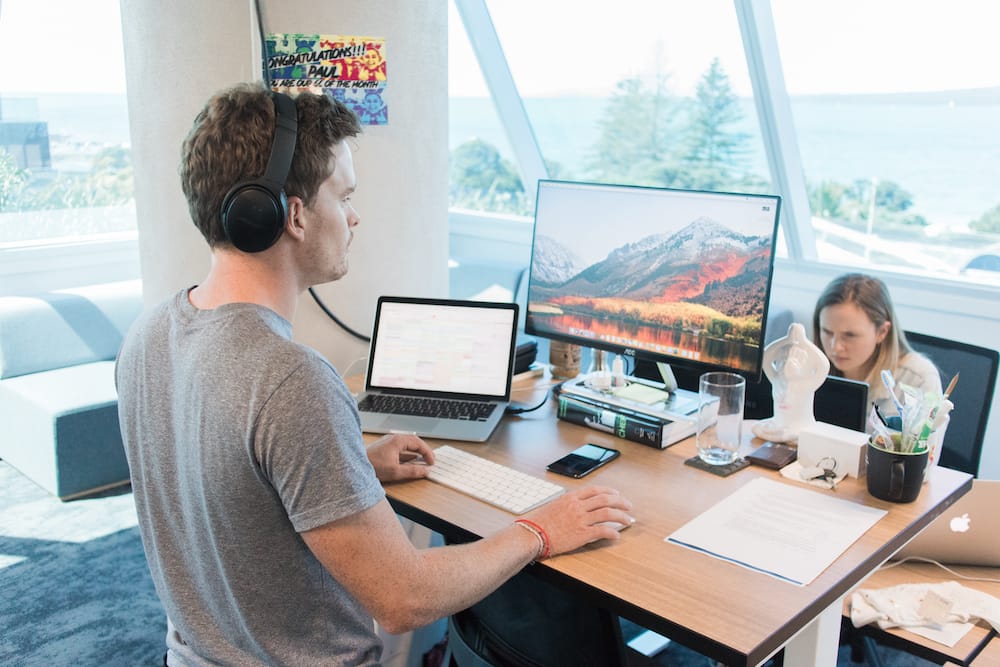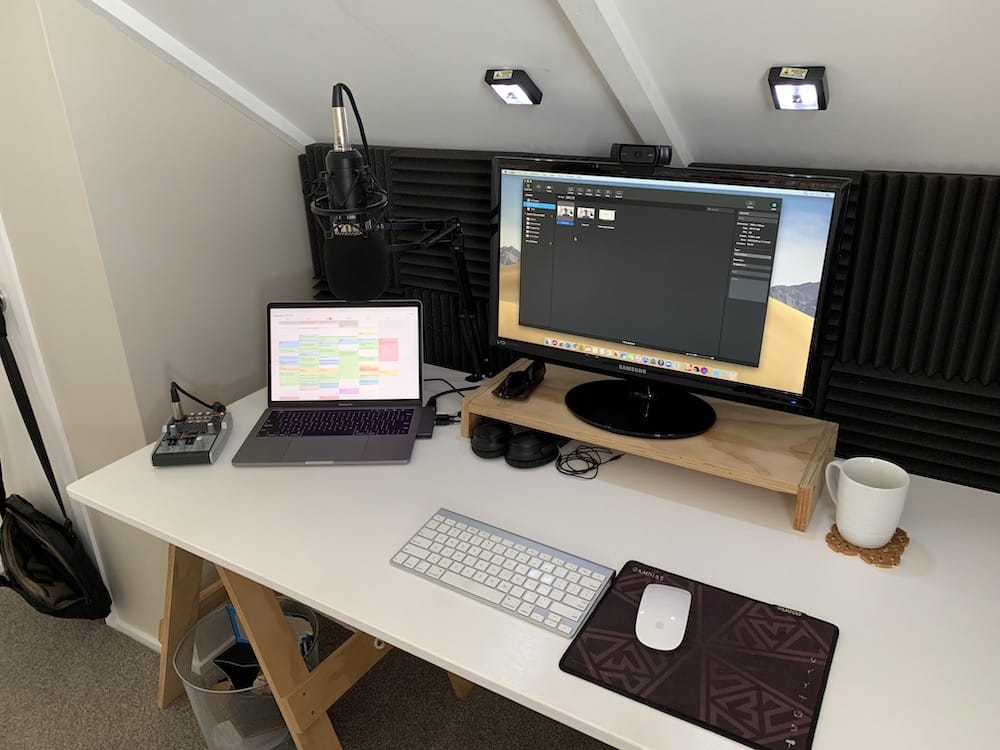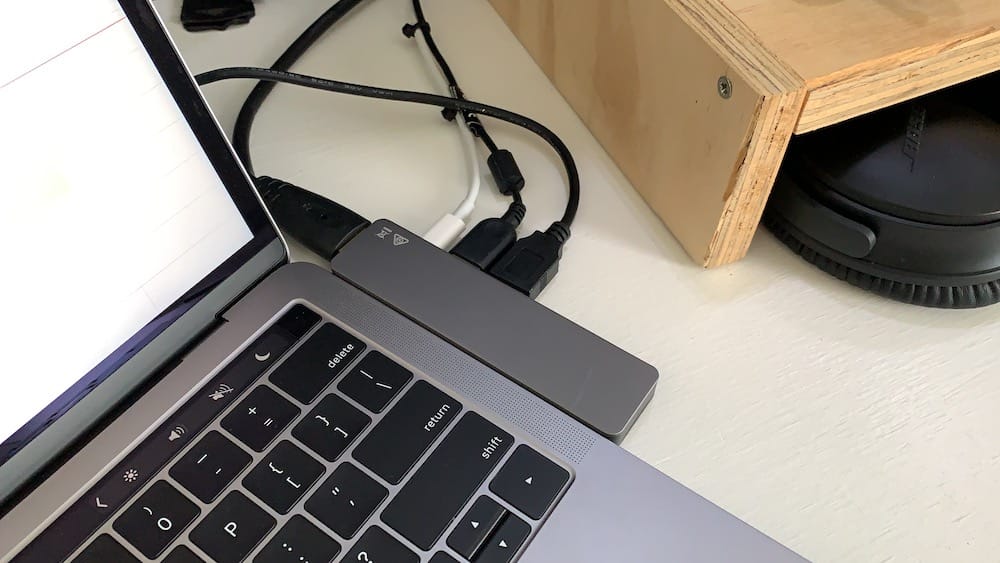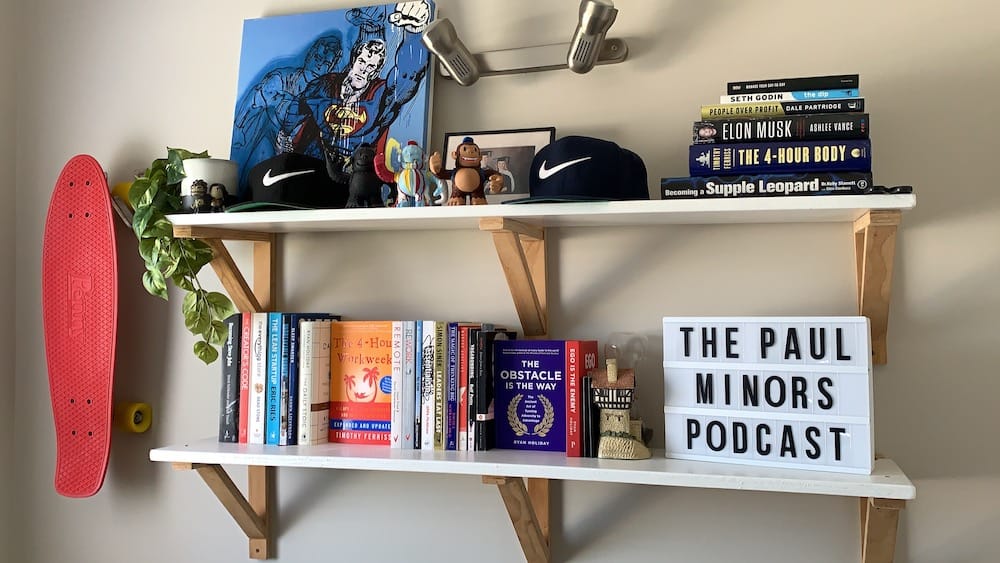After my interview with Miles last week, I got thinking about how to improve my home office set up. In the interview, we briefly discussed Mileses recording set up and after recording, I went about improving my own home office.
One of the things Mile’s said that really struck a chord with me was this idea of “reducing friction”. I love this idea and thinking about how you can minimise obstacles that stand between you and your work. I’ve been subconsciously doing this for a while, but since the interview, I’ve made an extra effort to optimise my workspace.
In regards to my office environment, I actually have two offices. Usually, at the start of my day, I work at a co-working space. I have a permanent desk in a shared environment. This is great as it means I can socialise and connect with other business owners. The second half of my day is spent at my home office. This is great for quiet work and content creation as I can’t really record podcasts or video in a shared workspace.

In this post, I’m primarily talking about home office space.

Don’t want to read this post, listen or watch below:
[youtube https://www.youtube.com/watch?v=JcQUD3291WA]Reduce friction
To reduce friction, you need to start by listing the kinds of things you actually do in your workspace. Aside from answering email, what does your work involve? Do you need to make calls and video conference? Are you programming or working on creative endeavours? Do you need a space to spread out, plan and brainstorm ideas? Is your work physical and requires tools and materials?
When you actually think about the kind of work you do and your working style you can start to design an office space that’s optimised for your needs.
For example, if you’re doing creative work, you’ll likely want quick access to a whiteboard, stickies, printer and other materials. A more focused worker may need a quieter space they can go to with no noise, visual distractions or even other people.
I do a mix of focused work, content creation and video conferencing. So I use different environments for different tasks.
I have an identical set up at home and the co-working space. Wherever I’m working, I have my MacBook connected to an external display, Logitech HD webcam (affiliate link) (for consulting calls) and power. Because I’m always moving my MacBook between the home and co-working space, I don’t want to worry about plugging and unplugging all my gear at either end (too much friction).
To make the transition easier, I purchased an extra MacBook charger, webcam and display so I can have one set up at home and one at the office. I have the charger, my display and webcam connected to my MacBook via a USB-C dongle. This means I can quickly dock my Mac and instantly connect to everything I need without fumbling with everything all the time. This makes transitioning from the office to home very easy. I can just grab my Mac and go.

When I’m working at home I’m usually working on content for my podcast and YouTube channel. Therefore I’ve optimised my set up so I can start recording very quickly:
- My podcasting microphone and mixer (affiliate links) are already set up on my desk. All I need to do is plug in one USB cable and I’m ready to go.
- I also have some $5 battery powered LED lights (from the hardware store) velcroed to my ceiling which I can quickly turn on when recording video.
This means when it’s time to record a podcast I can literally be ready to record in a matter of seconds. By eliminating friction I can support the content creation process by making it less of a daunting task.
PHOTO OF PODCAST SET UP
I want to add here that switching between two office spaces is a luxury. Most people have just one space. I’ve purchased the extra gear I need slowly over time and while it’s not 100% necessary to do my job, I enjoy the change in scenery when working from two different spaces.
Learn how to 'reduce friction' in your work environment and improve your productivityClick To TweetDeclutter your space
Something else I’ve done to reduce friction is to declutter my space. This means no paper, desk toys or unnecessary items on my desk. In fact, besides my Mac, external display, keyboard, mouse and podcasting mic, I don’t really have much of anything on my desk.
When I inevitably have to deal with paper, it goes onto my desk temporarily as an indicator that I need to deal with it. For example, receipts I’ve received that I want to store or invoices to be paid are put on the side of my desk. The very act of putting it on the desk lets me know I need to do something with it.
After I’ve dealt with the paper, it gets scanned if I need to keep it and then thrown away (I use Scanbot for iPhone and Android). Scanbot actually scans the document for text meaning all of my documents are instantly searchable. I find it’s a lot easier to find digital documents by searching on your computer than it is to go through a filing cabinet.
In fact, I run an almost 100% paperless business and lifestyle.
The only physical paper I have stored in a file is our wedding certificate, birth certificates and my New Zealand citizenship certificate. All other receipts, invoices, insurance documents, company documents etc. are stored electronically in Dropbox.
By eliminating clutter and going paperless, my home office is very minimal and helps me to feel more organised. Physical clutter tends to stress us out. So if you ever feel overwhelmed, start by tidying up your environment and you’ll very quickly start to calm down.
Make it your own
Naturally, you should customise your space based on how you like to work. So if you like brainstorming on a whiteboard or jotting ideas down in a physical notebook that’s fine.
I set up some shelves behind my desk and my wife, Hayley, has displayed some books and stuff to create an interesting background when recording video. Just a few weeks ago I wanted to fill some of the empty space on the walls so I hung up some skateboards that we had in the garage and weren’t using.

I was also having some WiFi issues in the office and my connection would occasionally drop out while on a conference call (not ideal when you make a living online). To remedy this I purchased a Netgear Powerline (Amazon affiliate link) which I’ve used to set up my own private network in the home office. It uses the power lines in the house to take the internet from our modem downstairs and create a new access point in the office.
Again, less friction.
Share your space
I’d love to see what you’ve done to optimise your workspace. If you’d like to share your set up, comment with a picture below!
